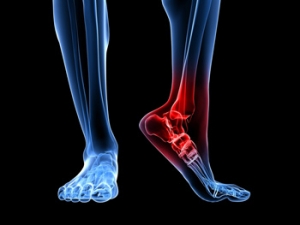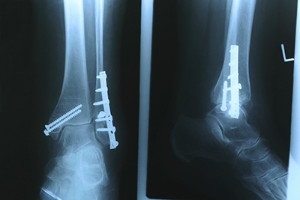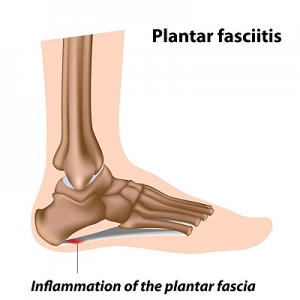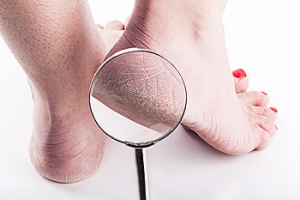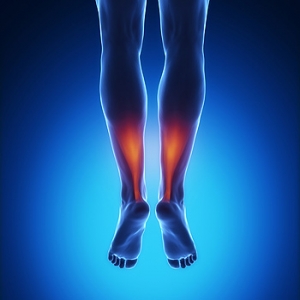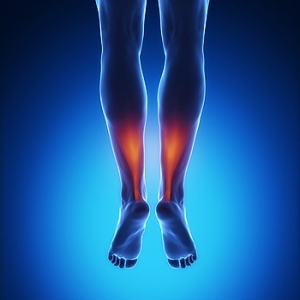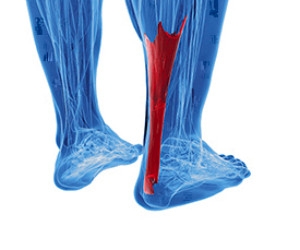Connect With Us
Featured Articles
Super User
Where Is the Plantar Fascia?
 The portion of tissue that is found on the bottom of the foot is called the plantar fascia. It connects the heel to the toes, and helps to provide flexibility to the foot while walking and running. When this band of tissue becomes inflamed as a result of an injury or from overuse, the condition plantar fasciitis may develop. The symptoms that are generally associated with this condition can include severe pain and discomfort in the heel and surrounding area, and this pain may be worse in the morning after arising. Some patients find mild relief when the affected foot is rolled on a cold bottle, as this may be helpful in relaxing the affected muscles. If you suffer from plantar fasciitis, it is strongly suggested that you are under the care of a podiatrist who can properly treat this condition.
The portion of tissue that is found on the bottom of the foot is called the plantar fascia. It connects the heel to the toes, and helps to provide flexibility to the foot while walking and running. When this band of tissue becomes inflamed as a result of an injury or from overuse, the condition plantar fasciitis may develop. The symptoms that are generally associated with this condition can include severe pain and discomfort in the heel and surrounding area, and this pain may be worse in the morning after arising. Some patients find mild relief when the affected foot is rolled on a cold bottle, as this may be helpful in relaxing the affected muscles. If you suffer from plantar fasciitis, it is strongly suggested that you are under the care of a podiatrist who can properly treat this condition.
Plantar fasciitis can be very painful and inconvenient. If you are experiencing heel pain or symptoms of plantar fasciitis, contact Dr. Thong V. Truong from California. Our doctor can provide the care you need to keep you pain-free and on your feet.
What Is Plantar Fasciitis?
Plantar fasciitis is the inflammation of the thick band of tissue that runs along the bottom of your foot, known as the plantar fascia, and causes mild to severe heel pain.
What Causes Plantar Fasciitis?
- Excessive running
- Non-supportive shoes
- Overpronation
- Repeated stretching and tearing of the plantar fascia
How Can It Be Treated?
- Conservative measures – anti-inflammatories, ice packs, stretching exercises, physical therapy, orthotic devices
- Shockwave therapy – sound waves are sent to the affected area to facilitate healing and are usually used for chronic cases of plantar fasciitis
- Surgery – usually only used as a last resort when all else fails. The plantar fascia can be surgically detached from the heel
While very treatable, plantar fasciitis is definitely not something that should be ignored. Especially in severe cases, speaking to your doctor right away is highly recommended to avoid complications and severe heel pain. Your podiatrist can work with you to provide the appropriate treatment options tailored to your condition.
If you have any questions please feel free to contact our office located in Chico, CA . We offer the newest diagnostic and treatment technologies for all your foot and ankle needs.
Painful Injuries to the Achilles Tendon
 There are noticeable symptoms that exist with an Achilles tendon injury. These can include pain near your heel, soreness after arising in the morning, and difficulty flexing or pointing the foot. Additionally, there may be a “popping” sound that happens at the time of the injury. The Achilles tendon connects the calf muscles to the heel, and can be significantly uncomfortable if an injury occurs. Consistent stress to the tendon may come from wearing shoes that do not fit correctly, participating in a new sporting activity, or exercising on uneven surfaces. Moderate relief may be found when the affected foot is elevated, as this may help to alleviate a portion of the swelling. Some patients find it can be beneficial to wear orthotics to help relieve discomfort as the healing process occurs. If you have endured an injury to your Achilles tendon, it is strongly advised that you consult with a podiatrist.
There are noticeable symptoms that exist with an Achilles tendon injury. These can include pain near your heel, soreness after arising in the morning, and difficulty flexing or pointing the foot. Additionally, there may be a “popping” sound that happens at the time of the injury. The Achilles tendon connects the calf muscles to the heel, and can be significantly uncomfortable if an injury occurs. Consistent stress to the tendon may come from wearing shoes that do not fit correctly, participating in a new sporting activity, or exercising on uneven surfaces. Moderate relief may be found when the affected foot is elevated, as this may help to alleviate a portion of the swelling. Some patients find it can be beneficial to wear orthotics to help relieve discomfort as the healing process occurs. If you have endured an injury to your Achilles tendon, it is strongly advised that you consult with a podiatrist.
Achilles tendon injuries need immediate attention to avoid future complications. If you have any concerns, contact Dr. Thong V. Truong of California. Our doctor can provide the care you need to keep you pain-free and on your feet.
What Is the Achilles Tendon?
The Achilles tendon is a tendon that connects the lower leg muscles and calf to the heel of the foot. It is the strongest tendon in the human body and is essential for making movement possible. Because this tendon is such an integral part of the body, any injuries to it can create immense difficulties and should immediately be presented to a doctor.
What Are the Symptoms of an Achilles Tendon Injury?
There are various types of injuries that can affect the Achilles tendon. The two most common injuries are Achilles tendinitis and ruptures of the tendon.
Achilles Tendinitis Symptoms
- Inflammation
- Dull to severe pain
- Increased blood flow to the tendon
- Thickening of the tendon
Rupture Symptoms
- Extreme pain and swelling in the foot
- Total immobility
Treatment and Prevention
Achilles tendon injuries are diagnosed by a thorough physical evaluation, which can include an MRI. Treatment involves rest, physical therapy, and in some cases, surgery. However, various preventative measures can be taken to avoid these injuries, such as:
- Thorough stretching of the tendon before and after exercise
- Strengthening exercises like calf raises, squats, leg curls, leg extensions, leg raises, lunges, and leg presses
If you have any questions please feel free to contact our office located in Chico, CA . We offer the newest diagnostic tools and technology to treat your foot and ankle needs.
Do I Have a Stress Fracture?
 A hairline fracture that gradually occurs may be defined as a stress fracture. It can happen as a result of frequently running or participating in sporting activities, and is known to develop from overuse. If a stress fracture is not promptly treated, it will typically get worse as the activity continues. The common symptoms that are associated with this condition may include swelling, pain and discomfort surrounding the affected area, and it may be difficult to walk. Factors that may lead to the development of a stress fracture can consist of wearing shoes that do not fit correctly, running on hard or uneven surfaces, or existing medical conditions such as osteoporosis. Relief may be obtained by elevating the affected foot, as this may help to reduce swelling. If you have endured a stress fracture it is suggested that you schedule a consultation with a podiatrist as quickly as possible, so proper treatment can begin.
A hairline fracture that gradually occurs may be defined as a stress fracture. It can happen as a result of frequently running or participating in sporting activities, and is known to develop from overuse. If a stress fracture is not promptly treated, it will typically get worse as the activity continues. The common symptoms that are associated with this condition may include swelling, pain and discomfort surrounding the affected area, and it may be difficult to walk. Factors that may lead to the development of a stress fracture can consist of wearing shoes that do not fit correctly, running on hard or uneven surfaces, or existing medical conditions such as osteoporosis. Relief may be obtained by elevating the affected foot, as this may help to reduce swelling. If you have endured a stress fracture it is suggested that you schedule a consultation with a podiatrist as quickly as possible, so proper treatment can begin.
Activities where too much pressure is put on the feet can cause stress fractures. To learn more, contact Dr. Thong V. Truong from California. Our doctor can provide the care you need to keep your pain free and on your feet.
Dealing with Stress Fractures of the Foot and Ankle
Stress fractures occur in the foot and ankle when muscles in these areas weaken from too much or too little use. The feet and ankles then lose support when walking or running from the impact of the ground. Since there is no protection, the bones receive the full impact of each step. Stress on the feet can cause cracks to form in the bones, thus creating stress fractures.
What Are Stress Fractures?
Stress fractures occur frequently in individuals whose daily activities cause great impact on the feet and ankles. Stress factors are most common among:
- Runners
- People affected with Osteoporosis
- Tennis or basketball players
- Gymnasts
- High impact workouts
Symptoms
Pain from the fractures occur in the area of the fractures and can be constant or intermittent. It will often cause sharp or dull pain with swelling and tenderness. Engaging in any kind of activity which involves high impact will aggravate pain.
If you have any questions please feel free to contact our office located in Chico, CA . We offer the newest diagnostic and treatment technologies for all your foot and ankle needs.
Inflammation of the Plantar Fascia
 Severe pain in the heel may be indicative of a condition that is known as plantar fasciitis. It occurs as a result of an inflammation of the plantar fascia, which is the portion of tissue that is on the bottom of the foot. Its function is to connect the toes to the heels, and it provides support to the arch. There are a variety of reasons why plantar fasciitis may develop. These can include obesity, standing for the majority of the day, and wearing high heeled shoes. Additionally, frequently participating in running and jumping activities that put strain on the plantar fascia may increase the possibilities of developing plantar fasciitis. A common symptom that many patients are aware of can consist of pain in the heel area for most of the day, and it may be worse upon arising in the morning. If you are afflicted with this painful ailment, it is strongly suggested that you consult with a podiatrist who can help you to manage this condition.
Severe pain in the heel may be indicative of a condition that is known as plantar fasciitis. It occurs as a result of an inflammation of the plantar fascia, which is the portion of tissue that is on the bottom of the foot. Its function is to connect the toes to the heels, and it provides support to the arch. There are a variety of reasons why plantar fasciitis may develop. These can include obesity, standing for the majority of the day, and wearing high heeled shoes. Additionally, frequently participating in running and jumping activities that put strain on the plantar fascia may increase the possibilities of developing plantar fasciitis. A common symptom that many patients are aware of can consist of pain in the heel area for most of the day, and it may be worse upon arising in the morning. If you are afflicted with this painful ailment, it is strongly suggested that you consult with a podiatrist who can help you to manage this condition.
Plantar fasciitis is a common foot condition that is often caused by a strain injury. If you are experiencing heel pain or symptoms of plantar fasciitis, contact Dr. Thong V. Truong from California. Our doctor can provide the care you need to keep you pain-free and on your feet.
What Is Plantar Fasciitis?
Plantar fasciitis is one of the most common causes of heel pain. The plantar fascia is a ligament that connects your heel to the front of your foot. When this ligament becomes inflamed, plantar fasciitis is the result. If you have plantar fasciitis you will have a stabbing pain that usually occurs with your first steps in the morning. As the day progresses and you walk around more, this pain will start to disappear, but it will return after long periods of standing or sitting.
What Causes Plantar Fasciitis?
- Excessive running
- Having high arches in your feet
- Other foot issues such as flat feet
- Pregnancy (due to the sudden weight gain)
- Being on your feet very often
There are some risk factors that may make you more likely to develop plantar fasciitis compared to others. The condition most commonly affects adults between the ages of 40 and 60. It also tends to affect people who are obese because the extra pounds result in extra stress being placed on the plantar fascia.
Prevention
- Take good care of your feet – Wear shoes that have good arch support and heel cushioning.
- Maintain a healthy weight
- If you are a runner, alternate running with other sports that won’t cause heel pain
There are a variety of treatment options available for plantar fasciitis along with the pain that accompanies it. Additionally, physical therapy is a very important component in the treatment process. It is important that you meet with your podiatrist to determine which treatment option is best for you.
If you have any questions, please feel free to contact our office located in Chico, CA . We offer the newest diagnostic and treatment technologies for all your foot care needs.
How Do Cracked Heels Develop?
 Severe cases of the condition known as cracked heels can cause extreme pain and discomfort. They are deep cracks in the skin that are known as fissures, and generally occur on the outside of the heel. It is an ailment that develops gradually, and will be manageable with prompt treatment. Some of the symptoms of cracked heels can include flaky and peeling skin, hardened and red skin, and the area may itch. Common causes of this condition can consist of standing for extended periods of time throughout the day, and wearing shoes that do not fit correctly. Additionally, certain medical conditions such as psoriasis and thyroid disease may play a significant role in developing cracked heels. Relief may be temporarily felt when a good moisturizer is applied to the affected area. If you would like more information about how to treat and prevent cracked heels from developing, it is suggested that you speak to a podiatrist.
Severe cases of the condition known as cracked heels can cause extreme pain and discomfort. They are deep cracks in the skin that are known as fissures, and generally occur on the outside of the heel. It is an ailment that develops gradually, and will be manageable with prompt treatment. Some of the symptoms of cracked heels can include flaky and peeling skin, hardened and red skin, and the area may itch. Common causes of this condition can consist of standing for extended periods of time throughout the day, and wearing shoes that do not fit correctly. Additionally, certain medical conditions such as psoriasis and thyroid disease may play a significant role in developing cracked heels. Relief may be temporarily felt when a good moisturizer is applied to the affected area. If you would like more information about how to treat and prevent cracked heels from developing, it is suggested that you speak to a podiatrist.
If the skin on your feet starts to crack, you may want to see a podiatrist to find treatment. If you have any concerns, contact Dr. Thong V. Truong from California. Our doctor can provide the care you need to keep you pain-free and on your feet.
Cracked Heels
It is important to moisturize your cracked heels in order to prevent pain, bleeding, and infection. The reason cracked heels form is because the skin on the foot is too dry to support the immense pressure placed on them. When the foot expands, the dry skin on the foot begins to split.
Ways to Help Heal Them
- Invest in a good foot cream
- Try Using Petroleum Jelly
- Ease up on Soaps
- Drink Plenty of Water
Ways to Prevent Cracked Heels
- Moisturize After Showering
- Skip a Shower
- Keep Shower Water Lukewarm
- Don’t Scrub Your Feet
If you are unsure how to proceed in treating cracked heels, seek guidance from a podiatrist. Your doctor will help you with any questions or information you may need.
If you have any questions, please feel free to contact our office located in Chico, CA . We offer the newest diagnostic and treatment technologies for all your foot care needs.
What Type of Running Am I Interested In?
 Research has indicated that it may be beneficial to purchase running shoes that are based on the shape of your foot. Additionally, it helps to know what type of running you are planning on doing, as this can aid you in choosing the right style of shoe. Many runners understand the importance of alternating shoes because it helps to prolong the life of the shoes. Feet are typically larger at the end of the day, which is why it’s recommended shoes are tried on at that time. An important quality to look for is a stiff heel, which provides adequate stability for the foot and ankle. If you would like additional information about the qualities to look for in running shoes, it is suggested that you consult with a podiatrist.
Research has indicated that it may be beneficial to purchase running shoes that are based on the shape of your foot. Additionally, it helps to know what type of running you are planning on doing, as this can aid you in choosing the right style of shoe. Many runners understand the importance of alternating shoes because it helps to prolong the life of the shoes. Feet are typically larger at the end of the day, which is why it’s recommended shoes are tried on at that time. An important quality to look for is a stiff heel, which provides adequate stability for the foot and ankle. If you would like additional information about the qualities to look for in running shoes, it is suggested that you consult with a podiatrist.
You should always make sure your running shoes fit properly in order to avoid injury. For more information, contact Dr. Thong V. Truong from California. Our doctor can provide the care you need to keep you pain-free and on your feet.
Choosing the Right Running Shoe for Your Foot Type
Improper shoe sizing can cause a myriad of problems for your feet. Shoes that don’t fit you properly can lead to muscular imbalances in your body, which can result in foot, knee, and hip injuries.
Tips for Finding the Right Running Shoe
- Make sure you have a thumb’s width of wiggle room between the end of your longest toe and the front of the shoe.
- There should be little to no slipping at the heel
- Don’t assume your size in one shoe brand will be your size in another
- Do not lace up your shoes too tightly
- Walk around in the store with your new shoes before you buy them
If you have any questions please feel free to contact our our office located in Chico, CA . We offer the newest diagnostic and treatment technologies for all your foot and ankle needs.
Choosing the Right Running Shoe
Choosing the right running shoes for you is an important part of running. A good pair of running shoes will make the running experience more enjoyable for you and prevent potential injury.
Poorly-fitted shoes can increase the risk of injury in runners substantially. Common injuries from running with poor quality shoes include shin splints, sprained ankles, Achilles tendinitis, stress fractures, plantar fasciitis and more. This is due to the fact that bad shoes do not provide proper foot support, can increase pronation (how much the foot rolls when hitting the ground), have little to no cushioning, do not allow the feet to breath, and do not provide enough flex and rigidity in the right parts.
When looking for running shoes, first, determine where you will be running. If you are a trail runner, then pick trail shoes. If you run on concrete and asphalt, then regular running shoes are the best choice. When trying on shoes, its best to go at the end of the day as feet grow during the day and shrink after a night of sleep. Shoes should be more rigid towards the back of the foot while being more flexible up where the toes are. The toe box should provide enough room for the toes to move freely. The overall fit should be snug, not too tight but not too loose. A good pair of running shoes should also provide enough arch support for your foot type. If you experience overpronation or under-pronation while running, try to find a pair of shoes that will help correct this with different sole patterns. Finally, try to find a pair of shoes that allow the feet to breathe like nylon mesh or synthetic leather.
Don’t forget about the socks either. Socks that hold too much moisture can lead to athlete’s foot. Socks should be breathable so that your feet can air out and breathe. Synthetic socks wick away moisture like sweat. If you tend to run a lot, having a second pair of shoes that you can wear while you let the first pair air out is smart. Just don’t forget to replace your shoes after about every 300 to 500 miles.
Before you start running, it is advised to see a podiatrist to see if running is right for you. They can also offer good advice on how to run and what to look for in a pair of running shoes. If you have flat feet or poorly supported ones, they can also offer custom-made orthotics that will help give your feet the support they need.
How Do Achilles Tendon Injuries Happen?
 The purpose of the Achilles tendon is to connect the calf muscles to the heel. This enables the patient to point and flex the foot, which is necessary in performing daily activities. If this tendon should become injured as a result of suddenly stepping off of a curb, intense pain can be felt in the back of the leg. Additional symptoms can include stiffness in the affected leg upon arising in the morning, and it may become swollen as the day progresses. Additionally, Achilles tendon injuries can occur if exercising is done on an uneven surface, consistently wearing shoes that do not fit correctly, or if a new sport is started. Moderate relief may be found when the foot is elevated, and this may help to reduce a portion of the swelling. If you feel you have injured your Achilles tendon, it is advised that you schedule an appointment with a podiatrist who can properly treat this condition.
The purpose of the Achilles tendon is to connect the calf muscles to the heel. This enables the patient to point and flex the foot, which is necessary in performing daily activities. If this tendon should become injured as a result of suddenly stepping off of a curb, intense pain can be felt in the back of the leg. Additional symptoms can include stiffness in the affected leg upon arising in the morning, and it may become swollen as the day progresses. Additionally, Achilles tendon injuries can occur if exercising is done on an uneven surface, consistently wearing shoes that do not fit correctly, or if a new sport is started. Moderate relief may be found when the foot is elevated, and this may help to reduce a portion of the swelling. If you feel you have injured your Achilles tendon, it is advised that you schedule an appointment with a podiatrist who can properly treat this condition.
Achilles tendon injuries need immediate attention to avoid future complications. If you have any concerns, contact Dr. Thong V. Truong of California. Our doctor can provide the care you need to keep you pain-free and on your feet.
What Is the Achilles Tendon?
The Achilles tendon is a tendon that connects the lower leg muscles and calf to the heel of the foot. It is the strongest tendon in the human body and is essential for making movement possible. Because this tendon is such an integral part of the body, any injuries to it can create immense difficulties and should immediately be presented to a doctor.
What Are the Symptoms of an Achilles Tendon Injury?
There are various types of injuries that can affect the Achilles tendon. The two most common injuries are Achilles tendinitis and ruptures of the tendon.
Achilles Tendinitis Symptoms
- Inflammation
- Dull to severe pain
- Increased blood flow to the tendon
- Thickening of the tendon
Rupture Symptoms
- Extreme pain and swelling in the foot
- Total immobility
Treatment and Prevention
Achilles tendon injuries are diagnosed by a thorough physical evaluation, which can include an MRI. Treatment involves rest, physical therapy, and in some cases, surgery. However, various preventative measures can be taken to avoid these injuries, such as:
- Thorough stretching of the tendon before and after exercise
- Strengthening exercises like calf raises, squats, leg curls, leg extensions, leg raises, lunges, and leg presses
If you have any questions please feel free to contact our office located in Chico, CA . We offer the newest diagnostic tools and technology to treat your foot and ankle needs.
Symptoms Of An Achilles Tendon Injury
The Achilles tendon connects the heel to the calf muscles, and it is located in the back of the leg, directly above the heel. It is known to be the largest tendon in the body, and if it should become injured, it may be difficult to walk and run. This tendon enables the foot to point and flex, in addition to standing on tiptoe. There are noticeable symptoms that exist if an Achilles tendon injury has occurred. These can include severe pain in the back of the leg, the inability to bend the foot, and some patients may also notice the ankle is bruised and weak. As the aging process occurs, it is important to perform proper stretches that can keep the Achilles tendon strong, and this may be helpful in preventing a painful injury from occurring. It can become torn or injured if you suddenly step off of a curb, which may overstretch the tendon. Moderate relief may be found when the affected foot is elevated, and it may feel comforting if an elastic bandage is wrapped around the foot to provide additional support. If you have injured your Achilles tendon, it is advised that you consult with a podiatrist who can properly treat this condition.
Achilles tendon injuries need immediate attention to avoid future complications. If you have any concerns, contact Dr. Thong V. Truong of California. Our doctor can provide the care you need to keep you pain-free and on your feet.
What Is the Achilles Tendon?
The Achilles tendon is a tendon that connects the lower leg muscles and calf to the heel of the foot. It is the strongest tendon in the human body and is essential for making movement possible. Because this tendon is such an integral part of the body, any injuries to it can create immense difficulties and should immediately be presented to a doctor.
What Are the Symptoms of an Achilles Tendon Injury?
There are various types of injuries that can affect the Achilles tendon. The two most common injuries are Achilles tendinitis and ruptures of the tendon.
Achilles Tendinitis Symptoms
- Inflammation
- Dull to severe pain
- Increased blood flow to the tendon
- Thickening of the tendon
Rupture Symptoms
- Extreme pain and swelling in the foot
- Total immobility
Treatment and Prevention
Achilles tendon injuries are diagnosed by a thorough physical evaluation, which can include an MRI. Treatment involves rest, physical therapy, and in some cases, surgery. However, various preventative measures can be taken to avoid these injuries, such as:
- Thorough stretching of the tendon before and after exercise
- Strengthening exercises like calf raises, squats, leg curls, leg extensions, leg raises, lunges, and leg presses
If you have any questions please feel free to contact our office located in Chico, CA . We offer the newest diagnostic tools and technology to treat your foot and ankle needs.
What Is the Purpose of the Achilles Tendon?
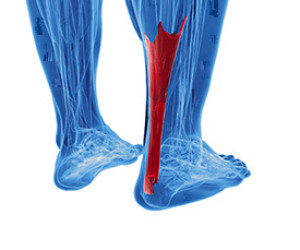 The largest tendon in the body is known as the Achilles tendon. Its function is to connect the heel bone to the calf muscles. Many tendons in the body are not flexible, and it is important to properly stretch this tendon before engaging in a sporting activity. If it should become irritated and inflamed, the result may be an Achilles tendon injury. The symptoms that are often associated with this type of injury can include tenderness, severe pain, discomfort, and the inability to bend the foot downward. If this tendon is not properly stretched, many people could tear their Achilles tendon if they start a new exercise regime, or increase the intensity considerably. There are numerous treatment options for this type of injury. If you feel you have injured your Achilles tendon, it is advised to consult with a podiatrist who can guide you toward the best treatment option.
The largest tendon in the body is known as the Achilles tendon. Its function is to connect the heel bone to the calf muscles. Many tendons in the body are not flexible, and it is important to properly stretch this tendon before engaging in a sporting activity. If it should become irritated and inflamed, the result may be an Achilles tendon injury. The symptoms that are often associated with this type of injury can include tenderness, severe pain, discomfort, and the inability to bend the foot downward. If this tendon is not properly stretched, many people could tear their Achilles tendon if they start a new exercise regime, or increase the intensity considerably. There are numerous treatment options for this type of injury. If you feel you have injured your Achilles tendon, it is advised to consult with a podiatrist who can guide you toward the best treatment option.
Achilles tendon injuries need immediate attention to avoid future complications. If you have any concerns, contact Dr. Thong V. Truong of California. Our doctor can provide the care you need to keep you pain-free and on your feet.
What Is the Achilles Tendon?
The Achilles tendon is a tendon that connects the lower leg muscles and calf to the heel of the foot. It is the strongest tendon in the human body and is essential for making movement possible. Because this tendon is such an integral part of the body, any injuries to it can create immense difficulties and should immediately be presented to a doctor.
What Are the Symptoms of an Achilles Tendon Injury?
There are various types of injuries that can affect the Achilles tendon. The two most common injuries are Achilles tendinitis and ruptures of the tendon.
Achilles Tendinitis Symptoms
- Inflammation
- Dull to severe pain
- Increased blood flow to the tendon
- Thickening of the tendon
Rupture Symptoms
- Extreme pain and swelling in the foot
- Total immobility
Treatment and Prevention
Achilles tendon injuries are diagnosed by a thorough physical evaluation, which can include an MRI. Treatment involves rest, physical therapy, and in some cases, surgery. However, various preventative measures can be taken to avoid these injuries, such as:
- Thorough stretching of the tendon before and after exercise
- Strengthening exercises like calf raises, squats, leg curls, leg extensions, leg raises, lunges, and leg presses
If you have any questions please feel free to contact our office located in Chico, CA . We offer the newest diagnostic tools and technology to treat your foot and ankle needs.
